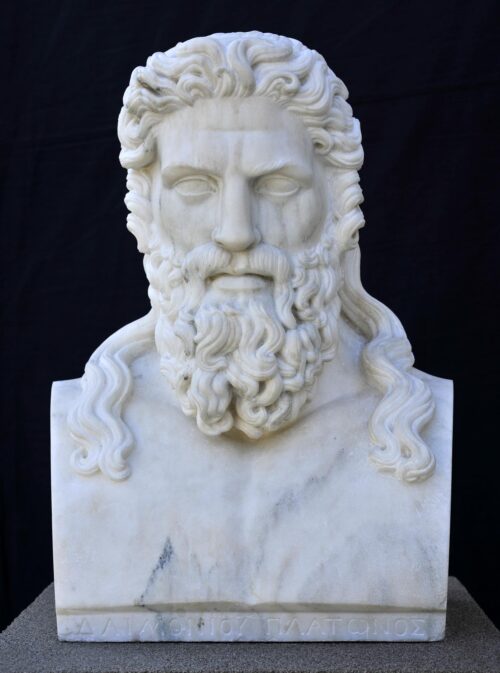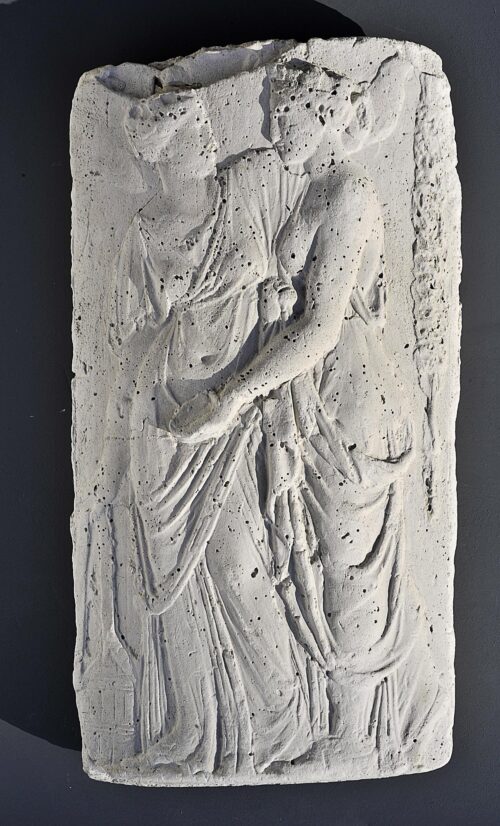
Prossalentis Pavlos the Elder (1784 - 1837)
Plato, 1815
He was descended from a family of nobles, which had its roots in Byzantium and which after the Fall of Constantinople emigrated to Corfu. After taking his first lessons in drawing and sculpture in his birthplace from the Italian wood-carver Luigi Bossi, he went to Rome in 1803 to continue his studies. Together with his compatriot and friend Dimitrios Trivolis-Pierris he enrolled at St. Luke’s Academy where they studied under the great neoclassical-style sculptor Antonio Canova.
In 1806 Prossalentis returned to Corfu and began to work. In 1808-1809 he participated in the founding of the Academy of Sciences, inaugurated by the French, and in 1811 founded a private Art School, the first in Greece, which in 1815 was made public, at the directive of the English High Commissioner Thomas Maitland. Moreover, after the founding of the Ionian Academy, Prossalentis was invited by Lord Guilford to teach drawing and sculpture. He accepted the position, but refused the salary Guilford offered him, asking that the money be made available for construction of copies of the marbles of the Parthenon which Elgin had taken to England, so they could be used as teaching aids in his school. Because in the end the copies were sent to him free of charge, he offered the money as scholarships for students at his school. In addition, although it appears he was not financially well-off himself, he gave lessons free of charge and the fee he charged for many works was only enough to cover the cost of materials and transport. He was also interested in the enrichment of his family’s archaeological collection and created a noteworthy collection of coins from ancient Egypt and Greece, from Corfu in particular. For his multifaceted offering to art he was decorated in 1820 by the High Commissioner and given the title of Knight of the Order of St. Michael and St. George.
Pavlos Prossalentis lived in the Ionian islands during a time favorable to artistic creation, since the foreign powers had created the preconditions for the development of young artists, with the building and decoration of important edifices and monuments. He took part in all kinds of artistic work being done on Corfu and took on, almost exclusively, all the sculpture commissions. He was, moreover, the first sculptor in Greece who managed to cast sculptures on bronze. But the constant casting did irreparable harm to his organism which in the end led to his death.
During the period 1806-1808 he worked in tandem with Dimitrios Trivolis-Pierris. They made primarily busts and objects with a mythological basis, which reveal their neoclassical training. After the death of his friend he continued to work alone, doing his most important work from 1815 to his death. A considerable number of his works have been lost or destroyed, others were taken to Britain while a smaller number have remained on the Ionian islands.
In 1815 he did the bust of Ingenious Plato which is now at the National Gallery and bears the inscription: “ΕΡΜΟΓΛΥ / ΦΙΚΗΣ / ΑΥΘΙΣ ΤΕΧΝΗΣ / ΚΟΡΚΥΡΑΙΩΝ / ΔΕΙΓΜΑ ΠΡΩΤΟΝ / ΤΟΥΤΟ ΠΑΥΛΟΣ / ΕΠΟΙΕΙ ΑΩΙΕ” (THIS IS THE FIRST EXAMPLE OF THE SCULPTURAL ART OF THE CORFIOTS DONE BY PAVLOS IN 1815), in an endeavor to delineate the very beginning of modern Greek sculpture. His artistic work, in addition to mythological subjects, also includes statues and busts, as well as reliefs set on pedestals. Among these are the bust of Thomas Maitland (1821-1822), the first to be done in bronze in modern Greek art, the bust of Frederic Adam (1825) and reliefs on bases as well as the statues of these two High Commissioners. In addition to the works he made on his own he also did supplementary work, or drawings for various others. He designed the more than life-sized statue of Britain which was placed at the peak of the facade of the Palace of St. George and St. Michael, as well as the reliefs with the symbolic representations of the seven islands, which ornament the metopes of the facade of the same palace. He also designed the outfits for the teachers and students at the Ionian Academy and made the four reliefs on the pedestal of the bust of the King of England George IV (1826) which was made by the English sculptor Francis Chantrey. The cast of this base is today in the National Gallery, where there are also his drawings and notebooks. In Platytera, on Corfu, there are also two of his icons.
Pavlos Prossalentis was one of the most important figures of his time. He brought the neoclassicistic doctrines of his Italian training to Corfu and, through the founding of his School, played a significant part in the dissemination of art education. And despite the fact that he lived and worked in his birthplace during a time when the Ionian islands were independent of Greece, his is in reality the first modern Greek sculptor, the one who liberated sculpture from its secondary and ornamental role, which had been imposed on it after Christianity became the dominant religion, and contributed to its renaissance.

Plato, 1815

Kefallinia and Ithaca (cast from the pedestal of the bust of king George IV of England in Corfu), 1826

We use cookies to make our site work properly, to personalize content and ads, to provide social media features and to analyze our traffic. We also share information about how you use our site with our social media, advertising and analytics partners. Read the Cookies Policy.
These cookies are necessary for the website to function and cannot be switched off in our systems. They are usually only set in response to actions made by you which amount to a request for services, such as setting your privacy preferences, logging in or filling in forms. You can set your browser to block or alert you about these cookies, but some parts of the site will not then work. These cookies do not store any personally identifiable information.
If you disable this cookie, we will not be able to save your preferences. This means that every time you visit this website you will need to enable or disable cookies again.
These cookies tell us about how you use the site and they help us to make it better. For example these cookies count the number of visitors to our website and see how visitors move around when they are using it. This helps us to improve the way our site works, for example, by ensuring that users find what they are looking for easily. Our website uses Google Analytics for statistics reporting.
Please enable Strictly Necessary Cookies first so that we can save your preferences!